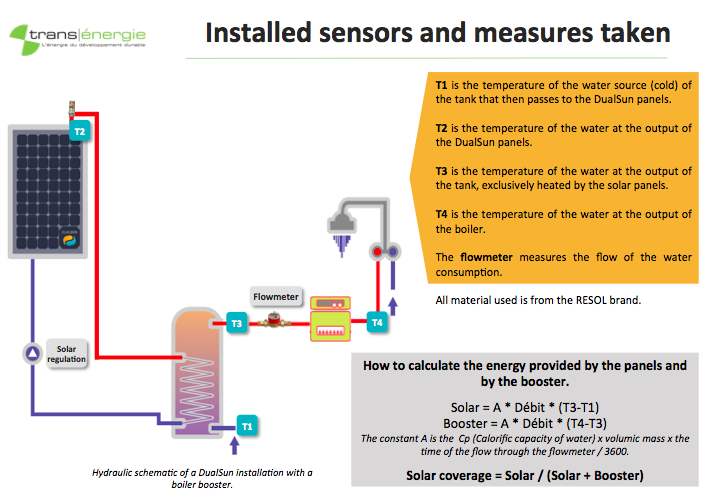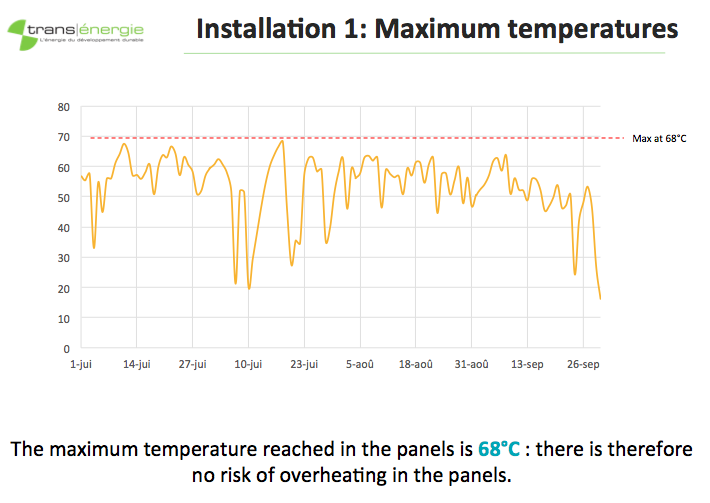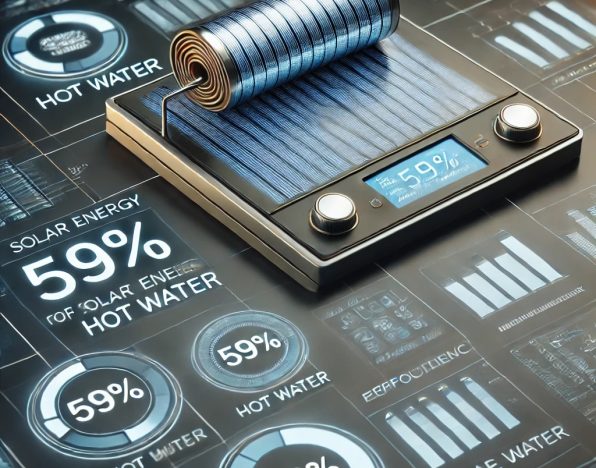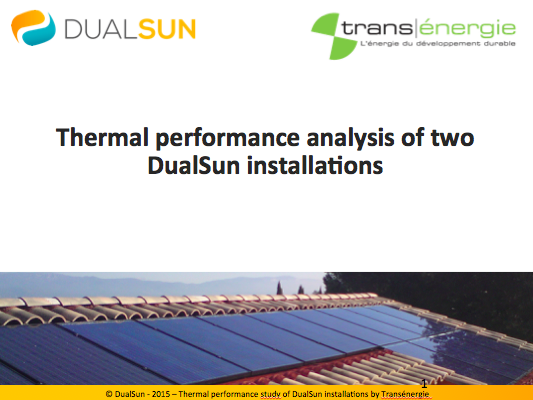How does one track the efficiency of a solar installation, when most often, solar hot water systems do not include monitoring equipment to measure the hot water production? At Dualsun, we are particularly attentive with regards to monitoring, not only to be transparent with our customers, but also to demonstrate the viability of the Dualsun system.
Dualsun has invested in and managed monitoring systems for the majority of its installations, and in 2014, Dualsun took a step further and asked engineering firm Transénergie to perform an in-depth study of the thermal performances of two Dualsun installations near Lyon (considered a reference average climate of France). One of the installations is building-integrated, meaning that that the panels replace the roof tiles and are “integrated” into the building envelope. The other project is an on-roof installation, a deliberate choice to be able to compare the impact of building-integration on thermal performance.
The study was conducted from April 2014 to April 2015. Transénergie delivered the first results for April to December 2014.
Monitoring system installed by Transénergie
The selection of the engineering firm and the installations
We chose Transénergie for the company’s experience, objectivity, and reputation. The engineering firm has over 20 years of experience in solar and renewables energies.
 The two installations selected for this study are situation in St Genis-les-Ollières (69-Rhônes) and Ambérieu (01-Ain). The first installation, the building-integrated installation, is composed of 6 Dualsun panels and 6 PV panels. The second is composed of 4 Dualsun panels next to 10 PV panels. The two installations have been operating since 2013 and are equipped with monitoring systems that allow to track in real-time data regarding the thermal performance and behavior of the panels.
The two installations selected for this study are situation in St Genis-les-Ollières (69-Rhônes) and Ambérieu (01-Ain). The first installation, the building-integrated installation, is composed of 6 Dualsun panels and 6 PV panels. The second is composed of 4 Dualsun panels next to 10 PV panels. The two installations have been operating since 2013 and are equipped with monitoring systems that allow to track in real-time data regarding the thermal performance and behavior of the panels.
What equipment used to measure hot water production?
In order to precisely measure the thermal performance of the two installations, specific monitoring equipment was implemented (from the company RESOL) including temperature sensors, a calorimeter and a flowmeter:
The energy generated in the form of hot water is measured by calculating the difference in temperature between the tank input (measured by sensor T1), the output of the tank (T3), multiplied by the flowrate in the pipes (measured by the flowmeter at the output of the tank).
The sensors will allow us to measure not only the energy provided by the solar panels, but also the “backup” energy needed to complete the heating (natural gas for both installations).
As a reminder, this Transénergie study is only focused on the thermal performance of the Dualsun panels, not the photovoltaic/electric performance.
Measured results from April 2014 to April 2015
Installation #1 (St Genis): During the summer months, the maximum temperature in the panels varies between 62°C and 68°C, thus allowing to completely meet hot water needs, while avoiding any risk of overheating in the panels.

During the summer (from June to September), Dualsun provides almost complete autonomy in termes of hot water needs with solar coverage of 94%. From January to December solar coverage is 59%.

Installation #2 (Ambérieu): The study shows us that the maximum temperature in the panels varies between 53°C et 67°C, again meet hot water needs without any risk of overheating in the panels. As the panels are non-integrated, this may explain the slightly lower temperatures.
From May to September, the solar panels meet 76% of hot water needs.
For more information regarding this study, we invite you to consult the powerpoint presentation:
The Transénergie study allows us to make several interesting conclusions about Dualsun installations:
First, that Dualsun panels provide almost full autonomy in terms of solar hot water during the summer and inter-seasonal months.
We also observe that there is absolutely no risk of overheating with the Dualsun panels. Overheating (surpassing temperatures of 100°C) is a considerable risk for the safety and lifespan of traditional solar hot water panels.
We can also conclude with this study that our simulation software provides energy production estimates that are very similar to measured results.
In order to further examine the efficiency of our panels, we plan to conduct a second study focused on the photovoltaic part of the installation in the upcoming months.
In conclusion, the Transénergie study and monitoring systems in general demonstrate the viability and high-performance of our hybrid solar technology. We highly encourage all of our customers to invest in a monitoring system to accompany their Dualsun installation, which will allow to track the thermal performance and general functioning of the system in real-time.


Aucun commentaire pour le moment